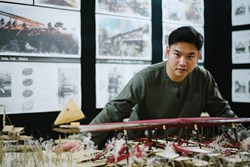Kamilla Melashchenko from Te Herenga Waka—Victoria University of Wellington, Te Kura Waihanga—School of Architecture is a finalist for her project 'Dictionary of Displaced Women'.
Project description
The project "Dictionary of Displaced Women" explores how architecture can respond to experiences of displacement for women. The project proposes an allegorical framework for reimagining architecture as a vessel for memory and a tool for rebuilding self-identity.
The work is structured as a dictionary: a collection of fragments, drawings, and rituals that together construct an architectural language of movement and renewal. It draws inspiration from The Dictionary of the Khazars by Milorad Pavić, a novel that exists in both female and male versions. This project looks into the female version. The author's statement that "a man experiences the world outside of himself, in the universe, while a woman carries the universe inside her" informs the design investigation. The final outcome is a house for a displaced woman, an architecture that reveals the world she carries within.
The project unfolds through three books (dictionaries), each exploring a different stage of the nomadic experience: departure, search for home, and dwelling. Each dictionary contains design experiments that culminate in a final architectural proposal located at Castlepoint, New Zealand — the house.
The house for a displaced woman is composed of four volumes: a sleeping chamber, a nourishment and social space, a cleansing space, and a small library oriented toward the lighthouse. A living tree anchors the centrepoint of the house — an open courtyard. The tree is enclosed by permanent stone walls, while the lighter surrounding structures are designed to decay or be disassembled over time.
The project argues that architecture can restore a sense of self where bureaucracy erases it. It invites reflection on how we design for movement, memory, and care in a world increasingly defined by displacement. The "Dictionary of Displaced Women" offers an architecture of belonging that manifests through rituals and memory.






